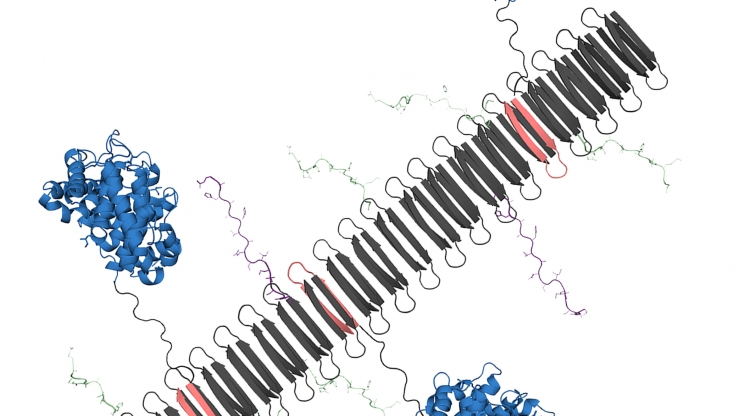创新背景
类风湿关节炎、克罗恩病和牛皮癣等炎症性疾病的特征之一,是导致炎症的信号蛋白——细胞因子的过度分泌。最重要的炎症细胞因子之一是一种叫做TNF的蛋白质。目前,治疗这些疾病的最佳方法是使用被称为单克隆抗体的人造抗体,其目的是针对和摧毁TNF并减少炎症。
尽管单克隆抗体能够更好地治疗炎症性疾病,但这种疗法也存在缺点,包括成本高,需要患者自己定期注射。最重要的是,这些药物的疗效也参差不齐,因为它们有时可能根本不起作用,或者随着身体学会产生可以破坏药物的抗体而最终停止工作。
为了规避这些问题,研究人员一直在探索免疫疗法如何帮助免疫系统产生自己的治疗性抗体,从而专门限制炎症。
创新过程
C3dg是一种通常能在体内找到的蛋白质。这种蛋白质帮助先天免疫系统和适应性免疫系统交流,因此它可以激活特定的白细胞和抗体,清除受损细胞,摧毁抗原。
由于这种蛋白质能够在免疫系统的不同细胞之间结合,并在不引起炎症的情况下激活抗体的产生,研究人员一直在探索如何将C3dg用作疫苗佐剂,这种蛋白质可以帮助增强对预期目标或病原体的免疫反应。

在他们的新纳米材料中,研究人员通过将含有TNF成分的C3dg蛋白的关键片段编织成纳米纤维来验证这一想法。C3dg蛋白将触发b细胞产生抗体,而TNF成分将提供抗体需要寻找和摧毁的蓝图。
当研究人员凯莉将C3dg蛋白和TNF的关键部分组装到这些纳米纤维中时,她看到了强烈的b细胞反应,这意味着针对TNF的抗体的生产增加了。在标准的炎症小鼠模型中,小鼠经历温度变化,其内部温度会下降。但当凯莉提供C3dg纳米纤维时,它具有高度的保护作用,小鼠没有出现炎症反应。
当该团队在银屑病小鼠模型中测试他们的纳米材料时,他们发现携带C3dg的纳米纤维与单克隆抗体治疗一样有效。因为C3dg通常存在于体内,所以它不会被抗药物抗体排出体外。

在检查了牛皮癣模型后,研究小组有了一个惊人的发现——C3dg不仅能刺激b细胞中的抗体产生,还能影响t细胞的反应。
他们观察到,只包含C3dg成分而不包含TNF成分的纳米纤维对模型仍然显示出治疗效益,最重要的发现是看到了一种有益的t细胞反应,它是由你人体中自然发现的一种蛋白质激活的,这种反应之前已经在其他蛋白质上发现过,但研究人员还没有看到任何关于人们对C3dg使用这种反应的报告。
下一步,研究小组希望进一步探索这种有益t细胞激活背后的机制。他们还将进行更多的实验,以探索类似的纳米材料在类风湿性关节炎模型中的反应。
创新关键点
在新纳米材料中,研究人员通过将含有TNF成分的C3dg蛋白的关键片段编织成纳米纤维来验证这一想法。C3dg蛋白将触发b细胞产生抗体,而TNF成分将提供抗体需要寻找和摧毁的蓝图。
创新价值
研究人员实质上是在寻找利用纳米材料诱导人体免疫系统成为抗炎抗体工厂的方法。如果这些疗法成功,患者需要更少的治疗剂量,这将在理想情况下提高患者的依从性和耐受性。这将是一种治疗炎症性疾病的全新方式。
Self-assembled nanofibers prevent damage caused by inflammation
C3dg is a protein normally found in the body. This protein helps the innate and adaptive immune systems communicate, so it can activate certain white blood cells and antibodies that wipe out damaged cells and destroy antigens.
Because of the protein's ability to bind between different cells of the immune system and activate antibody production without causing inflammation, researchers have been exploring how C3dg could be used as a vaccine adjuvant, where the protein could help boost immune responses to intended targets or pathogens.
In their new nanomaterials, the researchers tested this idea by weaving key fragments of the TNF-containing C3dg protein into nanofibers. The C3dg protein will trigger B cells to produce antibodies, while the TNF component will provide the blueprint the antibodies need to seek out and destroy.
When researcher Kelly assembled C3dg protein and key parts of TNF into these nanofibers, she saw a strong B-cell response, which meant increased production of antibodies against TNF. In standard mouse models of inflammation, mice undergo temperature changes and their internal temperatures drop. But when Kelly provided C3dg nanofibers, which were highly protective, the mice did not develop an inflammatory response.
When the team tested their nanomaterials in a mouse model of psoriasis, they found that C3DG-carrying nanofibers were as effective as monoclonal antibody treatment. Because C3dg is normally found in the body, it is not excreted by anti-drug antibodies.
After examining the psoriasis model, the team made a surprising discovery -- C3dg not only stimulated antibody production in B cells, but also influenced the response of T cells.
They observed that nanofibers containing only the C3dg component and no TNF component still showed therapeutic benefits to the model, and the most important finding was to see a beneficial T-cell response activated by a protein that is naturally found in your body, and that response has been seen previously with other proteins, But the researchers haven't seen any reports of people responding this way to C3dg use.
As a next step, the team hopes to further explore the mechanisms behind this beneficial T-cell activation. They will also conduct more experiments to explore the response of similar nanomaterials in a model of rheumatoid arthritis.
智能推荐
医学创新 | 通过激活自然杀手T细胞创新开发扩张性心肌病治疗方法
2022-11-14研究人员通过激活NKT细胞对DCM进行新的治疗,通过避免左心室辅助设备植入和心脏移植,有望改善严重心力衰竭患者的生活质量和生命预后。
涉及学科涉及领域研究方向血液病学创新 | 创新开发新型基因编辑技术可治疗儿童耐药性白血病
2022-11-03研究人员设计了供体T细胞,试图治疗患有耐药性白血病的重症儿童,这些儿童已经用尽了所有可用的治疗方法。
涉及学科涉及领域研究方向利用活性多肽治疗缺血性脑卒中
2022-07-02从山蛭中提取多肽,追本溯源反向利用活性多肽治疗缺血性脑卒中。
涉及学科涉及领域研究方向无人系统助力外科医生远程治疗中风
2022-07-29将机器人系统与中风治疗手术相结合,在中风开始后的关键时间窗口内为患者提供远程操作的血管内治疗。
涉及学科涉及领域研究方向